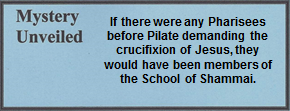02.01.19 School of Hillel. Rabbi Hillel, a/k/a Hillel the Elder, was one of the most important religious leaders in Israel during the time of Roman occupation. He was born in Babylon around 50 B.C., although a few sources date his birth as early as 110 B.C., and he died in A.D. 10. Because Isaiah said that the law should proceed forth from Jerusalem (Isa. 2:3), Jerusalem became the center of religious training. Hillel came to study in Jerusalem at the famous schools of Abtalion and Schemaiah.[1] About three decades before the birth of Jesus, he rose from the lowest ranks among the rabbis and became President of the Sanhedrin.
Hillel is at times romantically compared to Moses, as both supposedly lived to an age of 120. Hillel lived in Babylon for forty years, then studied for forty years, and in the last forty years he was a leader to his people. Those comments of are obviously somewhat fanciful, but reflect the high respect later generations had for him. He was also from the line of David, of Shephatiah, the son of Abital – a genealogical record that added to his credentials.[2] There is an excellent possibility that he and/or his students were in the temple when Jesus was there at the age of 12.
Hillel established an academy, which was known for its compassion toward fellow Jews and moral Gentiles. His school of biblical interpretation[3] held to the orthodox form of Judaism, but was known for its kindness, gentleness, and influence during the reign of Herod the Great (37 – 4 B.C.) and the childhood days of Jesus. He was a strict rabbi with a strong leaning to charity and mercy along with some Hellenistic or liberal ideas of the time. In fact, some of his ideas and ways of teaching the core values of the Torah were nearly identical to those of Jesus.[4] Scholars have often said that Jesus agreed much more with the teachings of Rabbi Hillel than with the opposing Rabbi Shammai.[5]
Since his teachings were often similar to those of Jesus, some scholars have suggested he was a significant element of “the fullness of time” phrase of Galatians 4:4b, in that he brought many people in line with what Jesus would be teaching. After the destruction of the temple, his followers became the dominant influence in Jewish lives. Leaders of both the Schools of Hillel and Shammai claimed to have heard a “voice from heaven,” even though on occasion they had strong contrasting interpretations of Scripture. It is difficult to classify either one as liberal or conservative. However, Hillel had a reputation for being kind and gentle while Shammai was impatient and abrasive.[6] (See last paragraph of 02.01.19 “School of Shammai” below.) One of the lasting contributions of Hillel was his seven rules of biblical interpretation.[7] Most Jewish scholars agree, however, these did not all originate with him, but he popularized them. See Appendix 30 for the complete listing.
Finally, Hillel’s family may have had more influence in biblical history than is commonly understood. Some scholars believe that it was his son Simeon who served in the temple and dedicated Jesus (Lk. 2:25-26).[8] The grandson of Hillel, Gamaliel, trained a student by the name of Saul, who became the famous Apostle Paul.[9]
[1]. Geikie, The Life and Works of Christ. 1:275.
[2]. Babylonian Talmud, Juchas. 19.2; Lightfoot, A Commentary on the New Testament from the Talmud and Hebraica. 3:35.
[3]. See Rabbi Hillel’s “Seven Guidelines or Rules of Interpretation” in Appendix 30.
[4]. Moseley, Yeshua: A Guide to the Real Jesus and the Original Church. 111.
[5]. Pixner, With Jesus through Galilee. 32.
[6]. Edersheim, The Life and Times of Jesus the Messiah. 91; Babylonian Talmud, Shabbath 31a.
[7]. There are multiple sources that explain Hillel’s Rules of Interpretation. His seven rules were later expanded into thirteen by Rabbi Ishmael. See Fischer, The Gospels in Their Jewish Context. (Lecture on CD/MP3). Week 11, Session 1.
[8]. See Lightfoot, A Commentary on the New Testament from the Talmud and Hebraica. 2:31.
[9]. Falk, Jesus the Pharisee. 48.
